
- Chess World Cup
- FIDE Grand Prix
- Olympiad
- World Championship
- List of strong tournaments
- List of world championships

- Checkmate patterns
- Chess openings
- Chess strategy
- Chess tactics
- Chess theory
- Endgames
- Pawn structure
- Problems/Compositions












Chess endgame literature refers to books and magazines about chess endgames. A bibliography of endgame books is below.
Many chess writers have contributed to the theory of endgames over the centuries, including Ruy López de Segura, François-André Philidor, Josef Kling and Bernhard Horwitz, Johann Berger, Alexey Troitsky, Yuri Averbakh, and Reuben Fine. Using computers, Ken Thompson, Eugene Nalimov, and others have contributed by constructing endgame tablebases.
Some endgame books are general works about many different kinds of endgames whereas others are limited to specific endgames such as rook endgames or pawnless endgames. Most books are one volume (of varying size), but there are large multi-volume works. Most books cover endgames in which the proper course of action (see list of chess terms#Optimal play) has been analyzed in detail. However, an increasing number of books are about endgame strategy, where exact analysis is not currently possible, due to the presence of more pieces. These endgame strategy books fill the gap from the end of the middlegame to where the other type of books takes over.
The study of a few practical endgames are found in Arabic manuscripts from the twelfth and thirteenth centuries. However, these are from before the rule of pawn promotion, so most are of little value today (Golombek 1977:101). A thirteenth-century Latin book by an unknown author examined the endgame of a knight versus a pawn, and formed the basis of later work by Alexey Troitsky in the twentieth century. In the fifteenth and sixteenth centuries a few types of endgames were studied, and opposition was known (Golombek 1977:101).
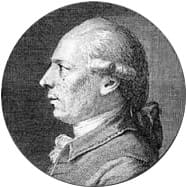 Philidor (1726-1795)
Philidor (1726-1795)Ruy López de Segura's 1561 book contained eight paragraphs on endgames. It used the Spanish rules in effect at the time, so a stalemate and baring the opponent's king were half-wins (Roycroft 1972:69). In 1617 Pietro Carrera published knowledge of several types of endgames, including queen versus two bishops, two rooks versus a rook and a knight, and two rooks versus a rook and a bishop. Several writers published books developing endgame theory: Gioachino Greco in 1624, Philipp Stamma in 1737, and François-André Philidor in 1749 (Stiller 1996:153). In 1634 Alessandro Salvio analyzed endgames, including a key position in rook endgames (Golombek 1977:101). Philidor's book contained much more endgame analysis than earlier books. The first edition analyzed the rook and bishop versus rook endgame. Later editions covered the bishop and knight checkmate, rook and pawn versus bishop, queen versus rook and pawn, queen versus rook, rook and pawn versus rook (including the Philidor position), queen and pawn versus queen, queen versus pawn on the seventh rank, knight versus pawn, two pawns versus one pawn, and two isolated pawns versus two connected pawns (Golombek 1976:121).
Lolli 1763| a | b | c | d | e | f | g | h | ||
| 8 |

     |
8 | |||||||
| 7 | 7 | ||||||||
| 6 | 6 | ||||||||
| 5 | 5 | ||||||||
| 4 | 4 | ||||||||
| 3 | 3 | ||||||||
| 2 | 2 | ||||||||
| 1 | 1 | ||||||||
| a | b | c | d | e | f | g | h | ||
In the eighteenth century important books were written by Italians (the "Modenese Masters") Domenico Lorenzo Ponziani, Ercole del Rio (1750), and Giambattista Lolli (1763) (Horwitz & Kling 1986). Lolli's book was based on del Rio's work and was one of the most important for the next 90 years. He studied the endgame of a queen versus two bishops and agreed with the earlier opinion of Salvio that it was generally a draw. Later this was overturned by computer endgame tablebases, when Ken Thompson found a 71-move solution. However, Lolli did find the unique position of mutual zugzwang in this endgame (see diagram) (Stiller 1996:154), (Nunn 2002:298). Lolli's 315-page book was the first giving practical research. His material came from several sources, including analysis by Philidor (Golombek 1977:101).
In 1766 Carlo Cozio published analysis of 127 endgame positions, but it was not a practical handbook (Golombek 1977:101). In 1851 Bernhard Horwitz and Josef Kling published Chess Studies, or endings of games, which contained 427 positions. In 1884 Horwitz added more than fifty positions to the book, retitled it Chess Studies and End-Games, and completely omitted Kling's name (Horwitz & Kling 1986). Other important books were Fins de parties d'echecs by Phillipe Ambroise Durand and Jean-Louis Preti in 1871, and Teoria e pratica del giuoco degli scacchi by Signor Salvioli in 1877 (Golombek 1977:101). Horowitz and Kling's analysis of the endgame of two bishops versus a knight had been questioned, and was eventually overturned by computer databases (see pawnless chess endgame) (Stiller 1996:154). In 1864 Alfred Crosskill published analysis of the endgame of rook and bishop versus rook, an endgame that has been studied at least as far back as Philidor in 1749 (Stiller 1996:154).
Howard Staunton in The Chess-Player's Handbook, originally published in 1847, included almost 100 pages of analysis of endgames (Staunton 1847:403-500). His analysis of the very rare rook versus three minor pieces endgame is surprisingly sophisticated. Staunton wrote, "Three minor Pieces are much stronger than a Rook, and in cases where two of them are Bishops will usually win without much difficulty, because the player of the Rook is certain to be compelled to lose him for one of his adversary's Pieces. If, however, there are two Knights and one Bishop opposed to a Rook, the latter may generally be exchanged for the Bishop, and as two Knights are insufficient of themselves to force checkmate, the game will be drawn." (Staunton 1847:439) Writing shortly before Staunton, George Walker reached the same conclusions. (Walker 1846:253-54) Modern-day endgame tablebases confirm Walker and Staunton's assessments of both endings (Müller & Lamprecht 2001:403). Yet Reuben Fine, 94 years after Staunton, erroneously wrote in Basic Chess Endings that both types of rook versus three minor piece endings "are theoretically drawn" (Fine 1941:521). Grandmaster Pal Benko, an endgame authority and like Fine a world-class player at his peak, perpetuated Fine's error in his 2003 revision of Basic Chess Endings (Fine & Benko 2003:524). Grandmaster Andrew Soltis in a 2004 book expressly disagreed with Staunton, claiming that rook versus two bishops and knight is drawn with correct play (Soltis 2004:84). Endgame tablebases had already proven that Staunton was correct, and Soltis wrong, although it can take up to 68 moves to win (Müller & Lamprecht 2001:403).
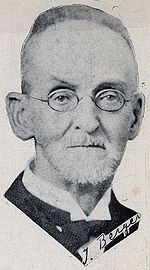 Johann Berger (1845-1933)
Johann Berger (1845-1933)The modern period of chess endgame books begins with Theorie und Praxis der Endspiele (Theory and practice of the Endgame) by Johann Berger. This was published in 1891, revised in 1922, and supplemented in 1933. This was the standard work on practical endgames for decades (Golombek 1977:101). Many later books were based on Berger's book (Purdy 2003:155-56). Edward Freeborough wrote a 130-page book of analysis of the queen versus rook endgame, The Chess Ending, King & Queen against King & Rook, which was published in 1895. Henri Rinck (1870-1952) was a specialist in pawnless endgames and A. A. Troitsky (1866-1942) is famous for his analysis of two knights versus a pawn (Stiller 1996:154). In 1927 Ilya Rabinovich published a comprehensive book in Russian titled The Endgame, which was designed for teaching. An updated version appeared in 1938 (Rabinovich 2012:7). (An English version of the second edition was published in 2012 as The Russian Endgame Handbook.) Eugene Znosko-Borovsky published How to Play Chess Endings in 1940.
In 1941, Reuben Fine published Basic Chess Endings, an attempt to collect all practical endgame knowledge into one volume. It is still useful today and has been revised by Pal Benko (Golombek 1977:101). Half of André Chéron's (1895-1980) book Traite Complet d'Echecs was about the endgame, and later he wrote Nouveau Traite Complet d'Echecs, which was a large book about the endgame. He later expanded that into the four-volume Lehr- und Handbuch der Endspiele in German, which was translated from the 1952 version in French (Purdy 2003:244). This was a major work for endgame studies but was not designed for the practical player.
Yuri Averbakh published a monumental set of books in Russian in 1956. The works were first published in English as several individual books (Pawn Endings, Bishop Endings, Knight Endings, Bishop v. Knight Endings, Rook Endings, Queen and Pawn Endings, Queen v. Rook/Minor Piece Endings, Rook v. Minor Piece Endings) and later collected into the five-volume Comprehensive Chess Endings. It was also published in other languages (Golombek 1977:101). Bobby Fischer had these books sent to him during his World Championship match (Averbakh & Chekover 1977:jacket). World Champion Max Euwe published the comprehensive eight-volume Das Endspiel in 1957 (Rosen 2003:7,9,172).
Some other major endgame books are Rook Endings by Grigory Levenfish and Vasily Smyslov (1971), Practical Chess Endings by Paul Keres (1973), Fundamental Chess Endings by Karsten Müller and Frank Lamprecht (2001), Dvoretsky's Endgame Manual by Mark Dvoretsky (2003), and Silman's Complete Endgame Course by Jeremy Silman (2007).
Here are some books on chess endgames in English.
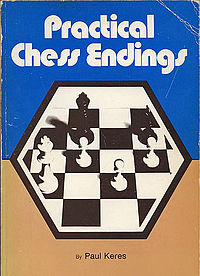 Practical Chess Endings by Paul Keres, 1981 paperback edition
Practical Chess Endings by Paul Keres, 1981 paperback edition Basic Chess Endings has appeared hardbound and softbound with several covers. This one is from 1971.
Basic Chess Endings has appeared hardbound and softbound with several covers. This one is from 1971.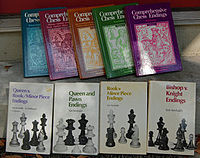 Works by Averbakh, some individual books and Comprehensive Chess Endings
Works by Averbakh, some individual books and Comprehensive Chess Endings

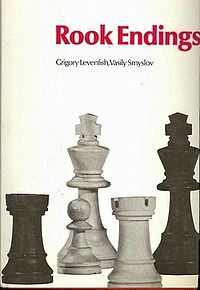 Cover of the 1975 hardback printing of Rook Endings.
Cover of the 1975 hardback printing of Rook Endings. |
 |
Strategic endgames are endgames that begin at the end of the middlegame. Usually each player has several pieces, making the position too difficult to analyze in detail. Therefore, it is usually not certain what the outcome should be or what is the best line of play.